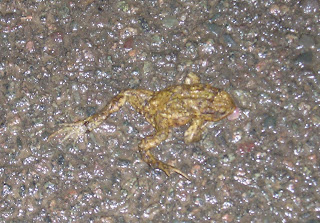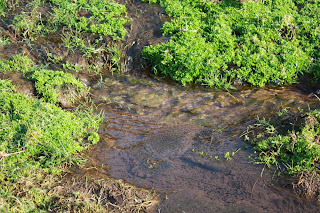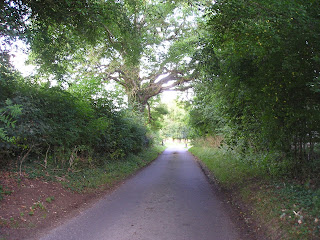Frog March
As night falls we have started hearing the sound of tapping at our garden door. It happens every year as the weather begins to warm up and the days draw out. At first we were uncertain as to what it was for there was no-one there when we looked outside. Yet, as soon as the door was closed, the gentle knocking sound would start again.
No, this is not the start of a scary story for on one occasion, leaving the door open a little longer than usual, into the house jumped a large frog, followed by several more. Now when we hear the sound we know that the frogs (and some toads) are on their march to their spawning grounds. Unfortunately this involves them crossing the little country lane just below our house and, although traffic is few and far between in the secret valley, each morning there are the squashed bodies of those that didn’t make it to the other side. The photo below may look as if it’s squashed but this one survived!
 Quite why the frogs cross here is a bit of a mystery. The river is below and to one side of us as it meanders through the valley and around the house. The frogs are coming from the field up on the hillside and this isn’t a nice, moist and lush grass field that might be a bit of froggy heaven. The field they come from is plough – stony, brashy and rough. Or have they been hibernating in the old hedgerow and, if so why, when there are plenty of, what would appear to be, more attractive and comfortable places to sleep? Whatever the reason, they are off back to the river and pond and our house is in their way. If the doors are open, a constant flow of ‘hoppers’ pass through the sitting room and kitchen – or around it as we tend to keep them out. When our little cottage was built 150 years ago, was it built on an ancient pathway created by thousands of generations of frogs?
Quite why the frogs cross here is a bit of a mystery. The river is below and to one side of us as it meanders through the valley and around the house. The frogs are coming from the field up on the hillside and this isn’t a nice, moist and lush grass field that might be a bit of froggy heaven. The field they come from is plough – stony, brashy and rough. Or have they been hibernating in the old hedgerow and, if so why, when there are plenty of, what would appear to be, more attractive and comfortable places to sleep? Whatever the reason, they are off back to the river and pond and our house is in their way. If the doors are open, a constant flow of ‘hoppers’ pass through the sitting room and kitchen – or around it as we tend to keep them out. When our little cottage was built 150 years ago, was it built on an ancient pathway created by thousands of generations of frogs?

 Oddly enough, on Exmoor, despite its harsh climate, the frogs spawn earlier than here in the secret valley. On a walk recently, we found this perfectly formed circular pond (perhaps an old sheep wash) on the moor and the frogs had already filled it with spawn. And in every boggy patch of the moor we found even more spawn. It rose above the water level in great mounds: perhaps it is the higher rainfall that prevents the spawn from drying out. However many frogs must there be and how many tadpoles will survive to return to breed in the future? The answer is mind boggling!
Oddly enough, on Exmoor, despite its harsh climate, the frogs spawn earlier than here in the secret valley. On a walk recently, we found this perfectly formed circular pond (perhaps an old sheep wash) on the moor and the frogs had already filled it with spawn. And in every boggy patch of the moor we found even more spawn. It rose above the water level in great mounds: perhaps it is the higher rainfall that prevents the spawn from drying out. However many frogs must there be and how many tadpoles will survive to return to breed in the future? The answer is mind boggling!

No, this is not the start of a scary story for on one occasion, leaving the door open a little longer than usual, into the house jumped a large frog, followed by several more. Now when we hear the sound we know that the frogs (and some toads) are on their march to their spawning grounds. Unfortunately this involves them crossing the little country lane just below our house and, although traffic is few and far between in the secret valley, each morning there are the squashed bodies of those that didn’t make it to the other side. The photo below may look as if it’s squashed but this one survived!
 Quite why the frogs cross here is a bit of a mystery. The river is below and to one side of us as it meanders through the valley and around the house. The frogs are coming from the field up on the hillside and this isn’t a nice, moist and lush grass field that might be a bit of froggy heaven. The field they come from is plough – stony, brashy and rough. Or have they been hibernating in the old hedgerow and, if so why, when there are plenty of, what would appear to be, more attractive and comfortable places to sleep? Whatever the reason, they are off back to the river and pond and our house is in their way. If the doors are open, a constant flow of ‘hoppers’ pass through the sitting room and kitchen – or around it as we tend to keep them out. When our little cottage was built 150 years ago, was it built on an ancient pathway created by thousands of generations of frogs?
Quite why the frogs cross here is a bit of a mystery. The river is below and to one side of us as it meanders through the valley and around the house. The frogs are coming from the field up on the hillside and this isn’t a nice, moist and lush grass field that might be a bit of froggy heaven. The field they come from is plough – stony, brashy and rough. Or have they been hibernating in the old hedgerow and, if so why, when there are plenty of, what would appear to be, more attractive and comfortable places to sleep? Whatever the reason, they are off back to the river and pond and our house is in their way. If the doors are open, a constant flow of ‘hoppers’ pass through the sitting room and kitchen – or around it as we tend to keep them out. When our little cottage was built 150 years ago, was it built on an ancient pathway created by thousands of generations of frogs? 
 Oddly enough, on Exmoor, despite its harsh climate, the frogs spawn earlier than here in the secret valley. On a walk recently, we found this perfectly formed circular pond (perhaps an old sheep wash) on the moor and the frogs had already filled it with spawn. And in every boggy patch of the moor we found even more spawn. It rose above the water level in great mounds: perhaps it is the higher rainfall that prevents the spawn from drying out. However many frogs must there be and how many tadpoles will survive to return to breed in the future? The answer is mind boggling!
Oddly enough, on Exmoor, despite its harsh climate, the frogs spawn earlier than here in the secret valley. On a walk recently, we found this perfectly formed circular pond (perhaps an old sheep wash) on the moor and the frogs had already filled it with spawn. And in every boggy patch of the moor we found even more spawn. It rose above the water level in great mounds: perhaps it is the higher rainfall that prevents the spawn from drying out. However many frogs must there be and how many tadpoles will survive to return to breed in the future? The answer is mind boggling!
The frog march has ended as they have reached their destination. When I walk past the large pond that has been formed by a breach of the river banks, the noise of croaking is amazing. Everywhere you look there are frogs and toads amongst the submerged vegetation. In the last 36 hours spawning has commenced - we have snow showers forecast over the next few days but, hopefully, it won't affect the spawn too much.




I cannot believe that frog survived in the roadway. Your post brings back memories of when I would collect tadpoles from our local creek as a child.
ReplyDeleteWe used to collect frogspawn as children and take it to school to keep in a big tank and watch the frogs grow.The wonder of it- frogspawn is protected now but still your post brought back the memories and the awe!
ReplyDeleteD'you know, elephants have age old pathways from place to place, and woe betide you if you block one as they'll just destroy what ever you put in their way. Maybe frogs are the same...we only once had an elephant come through our place though, and I think frogs would actually be preferable...
We used to collect spawn at school too - it was a great way to teach children about nature.
ReplyDeleteI assume, Heckety, that the elephant was when you lived somewhere other than Ireland? Or is this another example of the famous Irish blarney! Thanks, by the way, for the comments left elsewhere. Stoke Pero is not too far from the Doone Valley so perhaps it is mentioned in R D Blackmore's Lorna Doone - I don't recall it 'though.
Johnson
Perhaps my favorite entry yet! We had a similar experience each year living in Florida (US). Sadly, many places in the US have seen a sharp decline in frog and toad populations over the past few decades. I remember as a child gathering tadpoles every year to "raise" and release back into the wild. As a teacher I have noticed that this yearly event has gone by the wayside...too hard to find those little frogs-to-be, I suppose. It was heartening to read that you have an abundance in your part of the world! Thanks for the great pictures, too. This was a joy to read!
ReplyDeleteMost interesting!! LC
ReplyDeleteMany thanks Lisa & LC for your comments.
ReplyDeleteAs I am always saying, Lisa, I'm always amazed that anyone reads my blog and your kind words mean a lot to me. It will be a sad day when children can no longer watch tadpoles turn magically into tiny frogs, for it is these simple pleasures that teach them so much about life.
Johnson
Hello Johnson. It is surprising how early the frogs seem to arrive in our garden, I often feel that other bloggers don't believe me when I say we have spawn already :-) I want to shout 'It's true!' :-) Of course frogs have many predators. In our garden they have to outwit the neighbours cats and the herons!
ReplyDeleteHello Chris - it does seem that frogs spawn earlier in the West Country as I have known the Exmoor frogs for very many years! Here,in the Cotswolds, all the frogs are now congregating around the waters edge and the herons are having a field day. Johnson
ReplyDelete